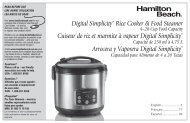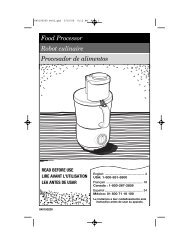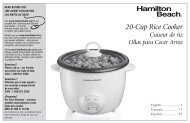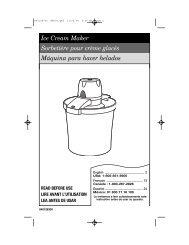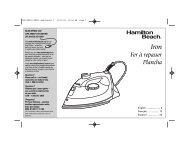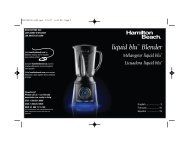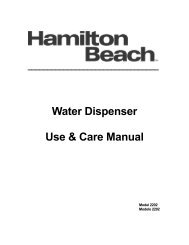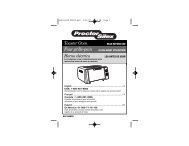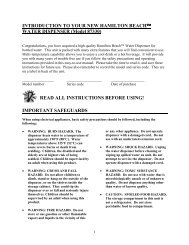How to Steam Iron - Hamilton Beach
How to Steam Iron - Hamilton Beach
How to Steam Iron - Hamilton Beach
You also want an ePaper? Increase the reach of your titles
YUMPU automatically turns print PDFs into web optimized ePapers that Google loves.
Tips for Best <strong>Iron</strong>ing Results<br />
FABRIC FACTS AND LABELS:<br />
Every fabric is different and should be treated accordingly. The label inside clothing or linens should recommend fabric care instructions that<br />
include ironing treatment. As a general rule, these instructions should be followed. If the fabric is a blend, use a low temperature setting. If you<br />
do not know what the content of the fabric is, use the lowest temperature first and test on an inside seam.<br />
PREPARE TO IRON:<br />
1. Cover your ironing board with a padded, heat-resistant cover. Brush or wipe off any dust, dirt, or debris so it doesn’t end up on your clothes.<br />
2. To set the height of the ironing board, stand with your elbows bent at right angles; then drop your hands slightly so that your arms are in a<br />
comfortable position. Set the height of your ironing board <strong>to</strong> this height.<br />
3. Check the soleplate (the surface of the iron that meets the fabric) for mineral deposits or scorched material before you begin ironing. If these<br />
deposits or minerals are left on the soleplate, they may end up on your clothes. Unsure? Test-glide the iron on a rag or old <strong>to</strong>wel first.<br />
TEST KITCHEN TIP: To clean an iron’s soleplate, preheat the iron <strong>to</strong> the highest temperature setting and iron over a damp, 100% cot<strong>to</strong>n cloth.<br />
This creates heavy steam that transfers grime from the soleplate <strong>to</strong> the cloth. Many irons have a Self-Clean But<strong>to</strong>n. This will clean the steam<br />
holes, but it will not remove grime from the flat surface of the soleplate. NOTE: Care should be used while cleaning; steam can burn.<br />
FAST FACTS:<br />
Don’t iron in a circular motion as this can stretch fabric. Instead, iron lengthwise.<br />
Natural fibers such as cot<strong>to</strong>n and linen should be ironed slightly damp for faster, easier ironing. If they are completely dry, use maximum<br />
steam while ironing or mist them with water prior <strong>to</strong> ironing.<br />
Any portion of a garment that has 2 layers of fabric such as pockets, seams, collars, and cuffs should be ironed inside out first.<br />
To press a collar, iron from the points in using small strokes of the iron. After wrinkles are pressed out, crease the collar in<strong>to</strong> place by hand—<br />
not with the iron. Treat French cuffs similarly, gently creasing by hand after ironing.<br />
IRONING VERSUS PRESSING:<br />
You may have heard the terms “ironing” and “pressing” used interchangeably, but they are actually quite different. When ironing, you slide the<br />
iron back and forth over fabric. When pressing, the iron is placed and held on the fabric in one spot, lifted up, and this process is repeated until<br />
the areas that need attention are smooth. A “pressing” technique is helpful <strong>to</strong> avoid stretching fabrics.<br />
A pressing cloth can help reduce unwanted “shine” on fabrics. You can purchase a pressing cloth in the laundry care section, or a clean white<br />
dish<strong>to</strong>wel or 100% cot<strong>to</strong>n pillowcase works equally well. You do not need <strong>to</strong> increase the recommended iron temperature when using a<br />
pressing cloth.<br />
9



